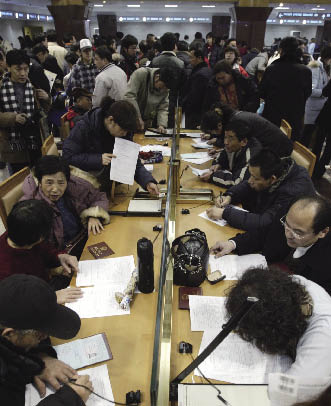| More Chinese Travelers Go It Alone
By CHEN HUI
IN June China’s first tour group to the U.S. visited major cities from coast to coast over 12 days. Most of the group of 200 were elderly and middle-aged people with the time and, more importantly, money to spare – the tour cost RMB 20,000 (just under US $3,000), or around one-third of the average annual income of Chinese urbanites.
“China has already become the fastest-growing source of tourists in Asia,” commented Wu Wenxue, vice president of the China Tourism Association, at the Third International Forum on Chinese Outbound Tourism last year. By the end of 2007, the Chinese government had approved 134 overseas destinations for Chinese tourists, 91 of which now officially accept Chinese citizens. From 1998 to 2007, the average annual growth of China’s outbound tourism was 23.5 percent, with numbers nearly quadrupling over the course of the decade. In 2007 alone the number of outbound travelers from the Chinese mainland amounted to 40.95 million person/times. The World Tourism Organization predicts that by 2015, China will become the world’s largest tourist destination country, and the fourth largest source of tourists. According to these estimates, by 2015 China’s outbound tourism will see 100 million individual departures annually.
Individual Travel More Popular
|

|
| Spring Festival is a busy season for the Beijing Police Exit and Entry Office, when the number of outbound tourists swells considerably. Cnsphoto |
Reforms to China’s national holiday system mean citizens now enjoy more vacations, and traveling abroad has become an increasingly popular choice among medium and high-income earners. According to the National Tourism Administration, Asian countries are Chinese people’s first preference; they provided destinations for 88.74 percent of China’s outbound tourists in 2007. While Southeast Asian countries, which were the first to open up to Chinese tourists, remain popular, the Republic of Korea and Kazakhstan have seen the biggest growth in the number of Chinese arrivals in recent years.
Difficulties in obtaining visas, language barriers and differences in living habits were once considerable obstacles for Chinese people traveling abroad, so tour groups were formerly the most popular travel mode. As the tourist market has matured and increasing numbers of Chinese people have gained travel experience, more and more people prefer to travel by themselves. The ROK, for example, has witnessed a rapid change in the main style of travel of Chinese visitors, from large tour groups to individuals. China is now the ROK’s second largest tourist source market.
Asia is still the easiest region for Chinese tourists to obtain visas for. In some major Chinese cities, it is possible to get a visa for Singapore through a chartered travel agency in just three working days. Singaporean visas now remain valid for entry for five weeks instead of three, and visitors can stay for up to 30 days.
Chinese tourists to the Philippines can apply for visas on arrival. Newlywed Zhou Yong paid a special trip to the island nation to enjoy the surfing, parachuting and hot air ballooning. “These adventure sports are few and far between in China, but are popular overseas, so we can enjoy them more easily,” explains Zhou.
In the summer of 2007, more convenient travel visas also became available for Australia. Unfortunately, European visas have remained restricted to tour groups, but many travel agencies now arrange tours with free time built in for visitors to explore villages in places like France or the Rhine in Germany. “Besides my photos, I only have a vague impression of where I went and what I saw,” says Mr. Li of his group package tour of Europe, that saw him visit 10 countries in 15 days. “I will never travel in that way again. Next time I will choose a particular European country, and enjoy its picturesque views, customs and culture.”
Many countries and regions are attempting to foster Chinese tourism through promotion of what they have to offer. For example, when Peter Fonseca, the Minister of Tourism for the Canadian province of Ontario, visited China in March last year, the former Olympic marathon runner brought information regarding the province’s world heritage sites and natural splendor.
A lot of young Chinese white-collar workers are wild about travel abroad, and working for foreigner companies has only whetted their appetite. “Working with a U.S. boss made me realize I lack an understanding of Western culture,” says Li Wei, a computer programmer with Bell Studio. “Traveling is a good way to gain this knowledge in the short term.”
According to Xu Jing, regional representative for Asia and the Pacific with the World Tourism Organization, China’s outbound tourist market has some problems associated with its immaturity. The industry’s focus, for example, tends to be limited to a handful of regions. Europe is the main long-distance destination for Chinese tourists, accounting for 44.5 percent of long-distance Chinese travelers in 2007.
|
